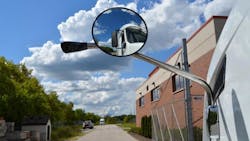The folks at PeopleNet will be clear: if you want a driver-facing camera, they can give you one with their truck video system. But it's still not an official option as two new cameras have been added — and here's why.
The two optional cameras now supplementing the PeopleNet system's original forward-facing camera are up by the truck's front fenders as part of spot mirrors, providing a view down the sides. Jim Angel, vice president of video intelligence solutions at the company, says it's a somewhat different tactic.
"A typical approach is to find some brackets, hook them to the existing side mirrors on the truck and get a picture going back," he tells Fleet Owner. "We looked at that initially too, but what we found was we'd be missing that blind spot out by the front tire of the truck, which is the most important one the driver can't see."
The answer for PeopleNet was to partner with an OEM spot mirror maker that also had an add-on camera product. One or both spot mirror cams can be added to the PeopleNet video system, which can accommodate up to four camera feeds into its digital video recorder, or DVR.
"What that does is it provides a view that intersects with our 150-degree forward-facing camera, so you've got complete coverage now around the cab," Angel says. There's a further innovation as well.
When the driver flips on the right turn signal, the right spot mirror camera, if equipped, can provide a live view on the truck's in-cab PeopleNet tablet. "Not only are we recording that in case of an event, we're also providing more visibility to the driver in the cab so they can see that blind spot on their screen right on their PeopleNet device," notes Angel.
Why no official driver-facing camera option?
Plenty of carriers and fleets will tell you they want to have a driver-facing camera as part of their video system. But among all the elements of truck video systems, that's the one at which drivers most frequently balk — and it's possible it could work against a carrier in more ways than that.
With PeopleNet's system, a driver-facing camera may not be an official option shown, but "it's totally up to the carrier," Angel says. "We can put a driver-facing camera in today if they want it."
"But the carriers are starting to understand the additional liability in what becomes available to a plaintiff's attorney when you have that," he adds.
Additional liability? Potentially, yes, according to Angel: he explains that in the event of a collision and a carrier being brought to court, an attorney could requisition all the video of that particular driver the carrier has. Even if the video shows the driver doing all the right things at the time of the collision, a possible strategy could be to look for any careless or negligent behavior in the driver's video history.
Should something along those lines — talking on a cell phone while driving, not wearing a seat belt, etc. — show up in the footage, "they're going to tell you as the carrier, 'Why didn't you address that when that happened?'" says Angel. "The attorney will say that if the carrier had terminated that driver, the driver wouldn't have been in this truck, in this intersection, on this day when their client hit you and got hurt.
"So the argument is that this particular driver shouldn't have even been there. Crazy as that sounds, we've already seen cases that are outlined just like that," he continues. "So I think that it has to be up to what the carrier wants to defend — and they'd better be prepared to defend it all."
Respect and trust issue
In the driver-facing camera discussion, Angel references an older article about a large national carrier moving to adopt such cameras in its trucks. He notes the article got maybe two dozen comments, most of which were negative and purportedly were from drivers.
"There were words like 'trust' and 'respect' used in a lot of those comments," he says.
Angel gives the example of his young son who'll soon be driving. "He knows his dad's in the video business. I've already told him, 'I'm going to have a camera on you — you touch that phone one time and your license is mine.'"
It's possible drivers may feel a little like that's the situation should a carrier put a camera on them in its trucks. "I get it; I fully understand the value of information from a driver-facing camera. But I also know that we have an aging work force," Angel points out, "and you might have 54-year-old truck drivers that've been driving for 20 years. You're entrusting them to drive your vehicle."
Of the fleets that've deployed the PeopleNet video system this year, not one of them has opted for driver-facing cameras. "There's got to be a reason that those carriers decided not to do that," says Angel.
In fact, the largest of the company's customers has opted for both the new spot mirror cameras, but went so far as to thoroughly check the camera views to be sure they weren't showing the driver's reflection in the windshield. "For them, it was all about showing respect to the drivers that they've hired to do what they do professionally," he contends.
Do you need it?
There's also been something of an oddity with another of PeopleNet's customers: the carrier was moving from an older video system that incorporated a driver-facing camera, but when purchasing the PeopleNet video system, the customer specifically chose not to include that camera again.
Angel found that a little unusual, he says, so if the customer didn't mind, could he ask why that was?
"They told me something that I found very enlightening," he tells Fleet Owner. "They said they've exonerated a ton of drivers with video, but had never once needed the driver-facing camera for that."
Still, he says, the decision ought to be up to the carrier to choose which cameras to include. The PeopleNet video product is different from systems that are triggered by accelerometers, Angel notes, in that it's tied in to the truck's telematics information and provides a depth of info on what the driver and truck are doing.
"We already have so much data on what the driver does. We have accelerator percentage; we have brake application; we have clutch; we have GPS; we have [electronic control module] speed and more," he says.
"So again, I fully understand the potential value of the information from a driver-facing camera. We just want to be able to provide the carrier what they want to do."




